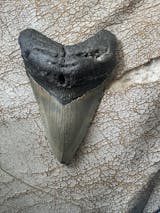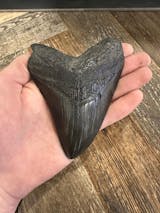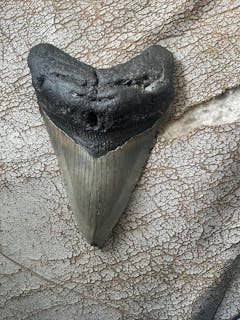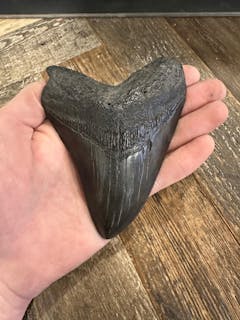This elegant fossil features a single brittle star (Ophiuroidea) from the Jurassic Period, preserved in a 5.50" x 4.00" slab of fine Moroccan limestone. The brittle star measures an impressive 3.50" across, with graceful, curling arms and a clearly defined central disc. The fossil’s contrast against the stone matrix and its natural articulation make it a visually compelling and scientifically valuable specimen.
Dating back over 150 million years, brittle stars like this one roamed the sea floor of ancient marine environments, using their long, flexible arms to scavenge and move across sediment. This specimen has been professionally prepared and is ideal for collectors, fossil enthusiasts, educators, or anyone fascinated by prehistoric ocean life.
Key Features:
- One fossil brittle star (Ophiuroidea)
- Measures 3.50" across
- Matrix dimensions: 5.50" x 4.00"
- Jurassic Period (~150 million years ago)
- Origin: Morocco
- Beautiful detail and contrast
🌊 About Fossil Starfish and Brittle Stars (Echinoderms)
Fossilized starfish and brittle stars — collectively known as echinoderms — are some of the most delicate and beautiful fossils preserved from Earth’s ancient oceans. While their modern relatives are still common on sea floors around the world today, their fossilized ancestors date back hundreds of millions of years, offering a rare glimpse into prehistoric marine ecosystems.
Starfish (class Asteroidea) and brittle stars (class Ophiuroidea) have been around since the Ordovician period, over 450 million years ago, and have changed very little in basic body structure. These fascinating creatures are echinoderms, meaning they are related to sea urchins, crinoids, and sea cucumbers. They are characterized by radial symmetry, spiny skin, and a water vascular system used for movement and feeding.
Due to their soft-bodied and fragile skeletons made of tiny calcareous plates, echinoderm fossils are exceptionally rare compared to harder-shelled marine animals like trilobites or ammonites. When preserved in full articulation — with arms extended and details visible — they become prized specimens among fossil collectors and paleontology enthusiasts.
Where Are Fossil Starfish and Brittle Stars Found?
Fossil starfish and brittle stars are found in fine-grained sedimentary rocks, where rapid burial and low-oxygen environments allowed these delicate animals to be preserved intact. Some of the most notable fossil localities include:
-
Morocco – Especially the Fezouata and Boulemane formations, which produce incredibly detailed brittle star slabs from the Ordovician and Jurassic periods.
-
Germany – The famous Solnhofen Limestone (Late Jurassic) yields exceptionally preserved brittle stars, sometimes alongside fish, pterosaurs, and other marine life.
-
United States – Sites in Kansas and Utah have produced fossil echinoderms from the Western Interior Seaway.
-
United Kingdom – Various Jurassic and Cretaceous formations yield occasional starfish fossils.
These fossils often appear in limestone matrix slabs, where the full outline of the animal — sometimes multiple individuals — is visible in beautiful detail.
What Makes Fossil Starfish & Brittle Stars Valuable?
Because of their rarity and fragile nature, fossil echinoderms are highly collectible. Several factors influence their desirability:
-
Completeness: Fully articulated specimens with intact arms and body detail are significantly more valuable than partial impressions.
-
Number of Individuals: Slabs with multiple starfish or brittle stars are especially eye-catching and collectible.
-
Preservation Detail: Clear surface textures, arm structures, and symmetry increase a fossil’s value.
-
Matrix Quality: A clean, attractive stone matrix makes for a stunning display piece.
-
Rarity of Species: Some genera or formations are less commonly available on the fossil market, raising their collectible status.
Why Collect Fossil Starfish and Brittle Stars?
These marine fossils capture a moment frozen in time — a window into ancient sea floors that existed long before the age of dinosaurs. Their visual appeal and scientific importance make them favorites among fossil lovers, educators, and gift-givers alike.
-
Educational Use: These fossils help teach about invertebrate evolution, marine ecosystems, and sedimentary fossil formation.
-
Display-Worthy: Their natural symmetry and detail make them incredible showpieces in both modern and rustic decor.
-
Conversation Starters: Few fossils are as instantly recognizable and appreciated as starfish and brittle stars.
-
Great Gifts: They’re ideal for ocean lovers, science enthusiasts, and fossil collectors of all experience levels.
Guaranteed Authenticity
At Fossil Driven, we proudly offer 100% authentic fossil starfish and brittle stars — carefully selected for quality, preservation, and scientific integrity. We clearly disclose any repaired or stabilized specimens and never deal in replicas or reproductions. Every fossil is a genuine piece of Earth’s prehistoric past, preserved through natural processes over hundreds of millions of years.
Add a rare and beautiful echinoderm fossil to your collection — a real star from Earth’s ancient oceans.









